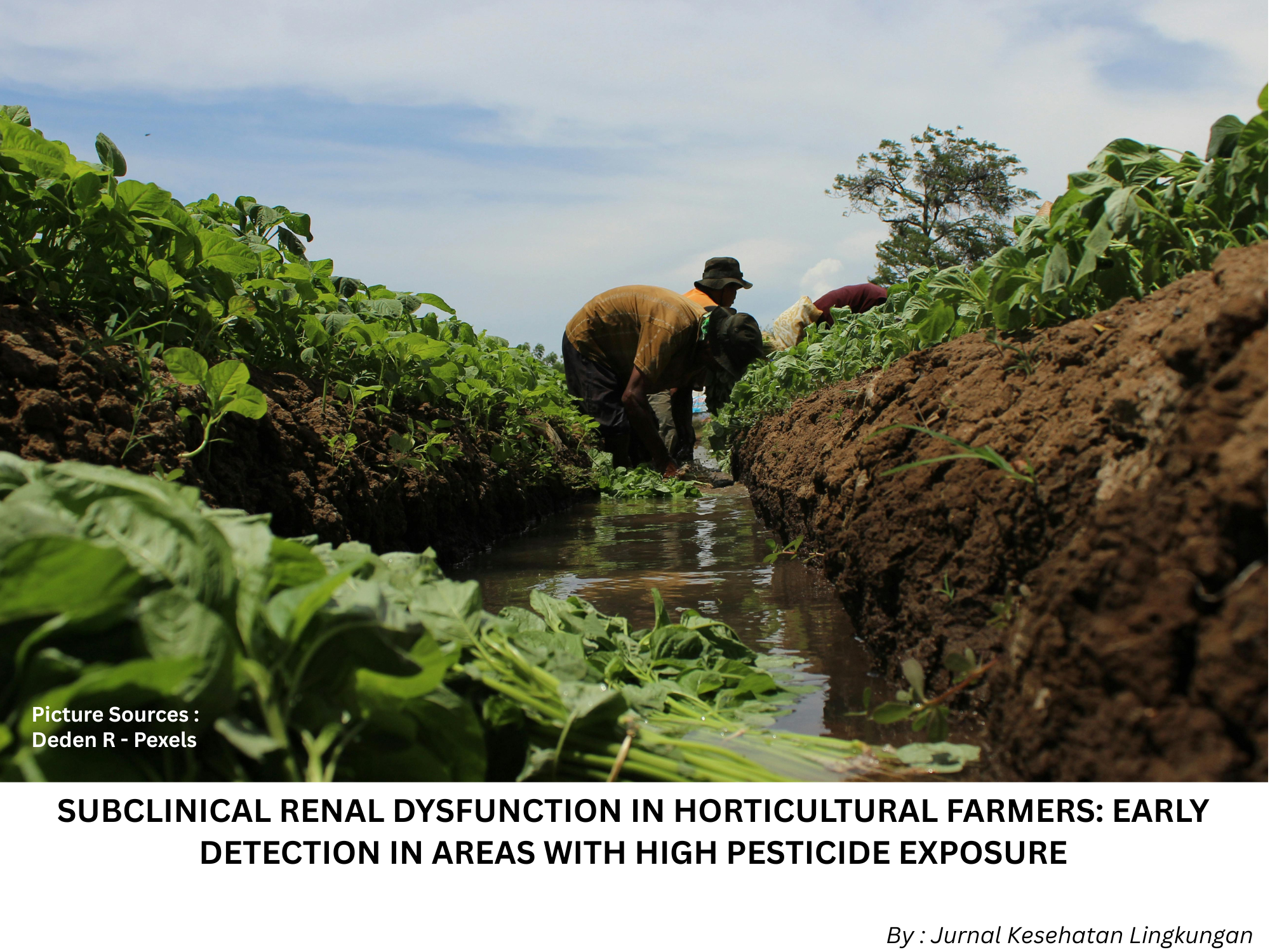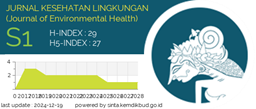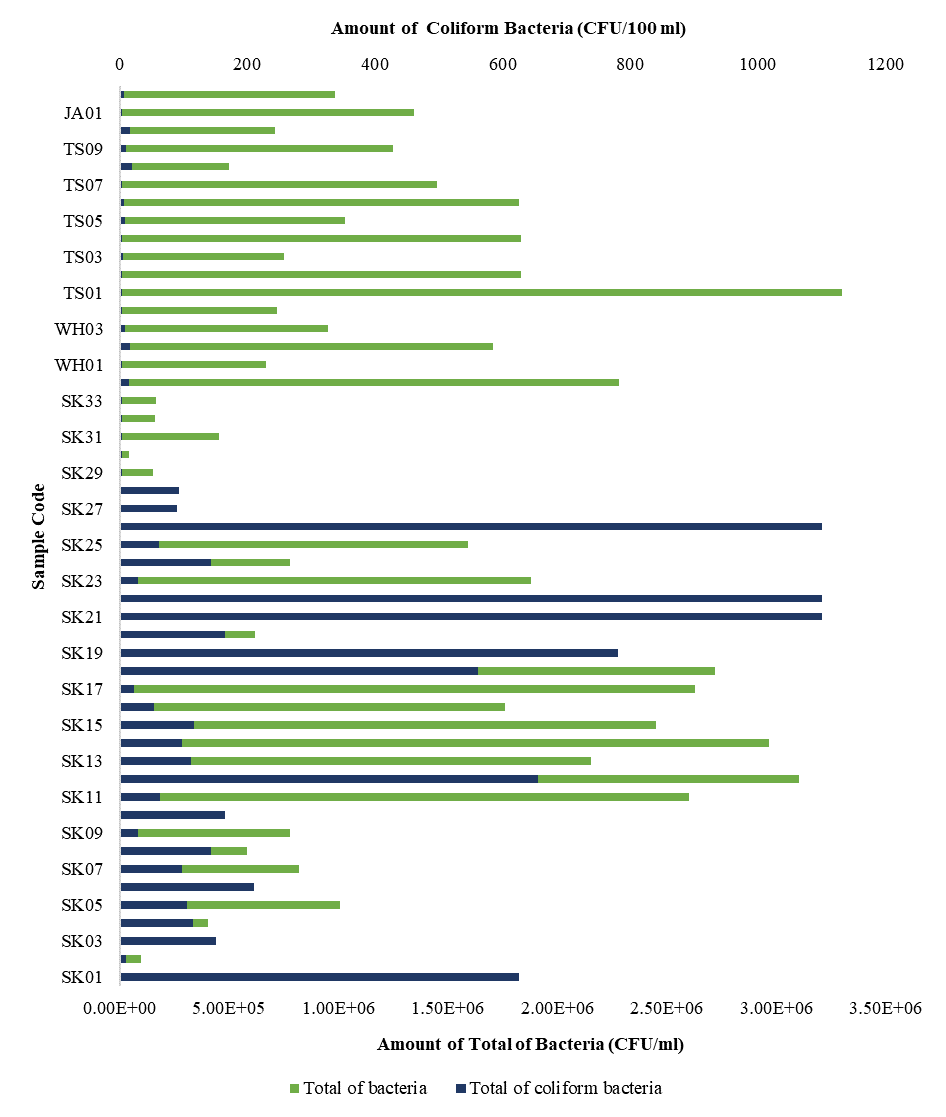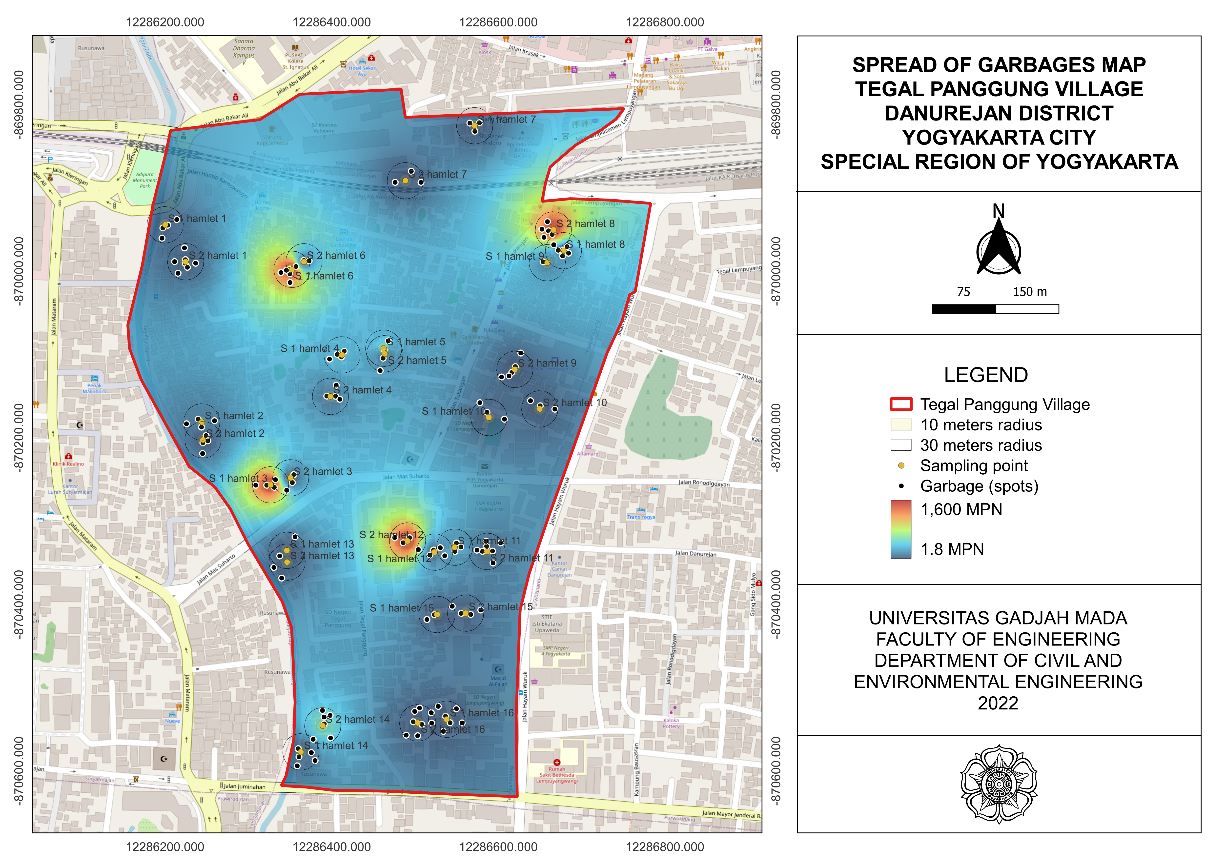Subclinical Renal Dysfunction in Horticultural Farmers: Early Detection in High Pesticide Exposure Areas

Downloads
Introduction: Globally, Chronic Kidney Disease of Unknown etiology (CKDu) poses a growing medical and social challenge, particularly in agrarian countries with a high prevalence of pesticide exposure. Indonesia, is one of the countries with a dominant agricultural sector. Tanjungsari and Glonggong villages in Wanasari subdistrict, Brebes Regency, are agricultural areas with a high intensity of pesticide use. Methods: This research aimed to identify the prevalence of subclinical renal dysfunction and associated risk factors in horticultural farmers in areas with high pesticide exposure. This research applied a cross-sectional method involving 40 farmers aged 26-65 years from two villages in Wanasari District, Brebes Regency. Data collection was carried out through interviews, and examination of kidney function biomarkers (serum creatinine and eGFR). Statistical analysis was conducted using Logistic Regression tests. Results and Discussion: The study revealed that 37.5% of participants exhibited eGFR values <90 ml/min/1.73 m2, indicating subclinical impairment of kidney function. Employment duration >20 years (p=0.024; OR=6.000; 95% CI:1.263-28.498) and daily working hours >6 hours (p<0.001; OR=69.279; 95% CI:6.423-756.965) showed a significant association with reduced eGFR values. Occupational health interventions should prioritize managing the duration and intensity of exposure to hazardous substances in the workplace, regardless of the workers' gender. Conclusion: The conclusion is that the daily working hours and the employment duration of the farmers are significantly associated with impaired kidney function, potentially acting as an initial marker of CKDu.
Kovesdy CP. Epidemiology of Chronic Kidney Disease: an update 2022. Kidney Int Suppl. 2022;12(1):7–11. https://doi.org/10.1016/j.kisu.2021.11.003
Venugopal V, Lennqvist R, Latha PK, Shanmugam R, Krishnamoorthy M, Selvaraj N, et al. Occupational Heat Stress and Kidney Health in Salt Pan Workers. Kidney Int Reports. 2023;8(7):1363–1372. https://doi.org/10.1016/j.ekir.2023.04.011
Javeres MNL, Habib R, Laure NJ, Shah STA, Valis M, Kuca K, et al. Chronic Exposure to Organophosphates Pesticides and Risk of Metabolic Disorder in Cohort from Pakistan and Cameroon. Int J Environ Res Public Health. 2021;18(5):1–13. https://doi.org/10.3390/ijerph18052310
Aguilar-Ramirez D, Raña-Custodio A, Villa A, Rubilar X, Olvera N, Escobar A, et al. Decreased Kidney Function and Agricultural Work: A Cross-Sectional Study in Middle-Aged Adults from Tierra Blanca, Mexico. Nephrol Dial Transplant. 2021;36(6):1030–1038. https://doi.org/10.1093/ndt/gfaa041
Rutter CE, Njoroge M, Cooper PJ, Prabhakaran D, Jha V, Kaur P, et al. International Prevalence Patterns of Low Egfr in Adults Aged 18-60 Without Traditional Risk Factors from A Population-Based Cross-Sectional Disadvantaged Populations Egfr Epidemiology (DEGREE) Study. Kidney Int. 2025;107(3):541–557. https://doi.org/10.1016/j.kint.2024.11.028
Zhu K, Wan Y, Zhu B, Zhu Y, Wang H, Jiang Q, et al. Exposure to Organophosphate, Pyrethroid, and Neonicotinoid Insecticides and Dyslexia: Association with Oxidative Stress. Environ Pollut. 2024;344(123362):1-10. https://doi.org/10.1016/j.envpol.2024.123362
Rajapaksha H, Pandithavidana DR, Dahanayake JN. Demystifying Chronic Kidney Disease of Unknown Etiology (CKDU): Computational Interaction Analysis of Pesticides and Metabolites with Vital Renal Enzymes. Biomolecules. 2021;11(2):1–32. https://doi.org/10.3390/biom11020261
Chen D, Parks CG, Hofmann JN, Beane FLE, Sandler DP. Pesticide Use and Inflammatory Bowel Disease in Licensed Pesticide Applicators and Spouses in the Agricultural Health Study. Environ Res. 2024;249(118464):1-11. https://doi.org/10.1016/j.envres.2024.118464
Ahmad MF, Ahmad FA, Alsayegh AA, Zeyaullah M, AlShahrani AM, Muzammil K, et al. Pesticides Impacts on Human Health and the Environment with Their Mechanisms of Action and Possible Countermeasures. Heliyon. 2024;10(7):1-26. https://doi.org/10.1016/j.heliyon.2024.e29128
Martin-Reina J, Casanova AG, Dahiri B, Fernández I, Fernández-Palacín A, Bautista J, et al. Adverse Health Effects in Women Farmers Indirectly Exposed to Pesticides. Int J Environ Res Public Health. 2021;18(11):1-17. https://doi.org/10.3390/ijerph18115909
Di D, Zhang R, Zhou H, Wei M, Cui Y, Zhang J, et al. Exposure to Phenols, Chlorophenol Pesticides, Phthalate and Pahs and Mortality Risk: A Prospective Study Based on 6 Rounds of NHANES. Chemosphere. 2023;329(138650):1-12. https://doi.org/10.1016/j.chemosphere.2023.138650
Chang CJ, Yang HY. Chronic Kidney Disease Among Agricultural Workers in Taiwan: A Nationwide Population-Based Study. Kidney Int Reports. 2023;8(12):2677–2689. https://doi.org/10.1016/j.ekir.2023.09.004
Badan Pusat Statistik. Sebaran Lokasi Usaha Tani Indonesia Subsektor Tanaman Pangan di Indonesia Tahun 2023. Jakarta: Badan Pusat Statistik; 2023. https://webgis-st2023.web.bps.go.id/
Kementerian Pertanian Republik Indonesia. Keputusan Menteri Pertanian RI No 379 Tahun 2020 Tentang Pemberian nomor Pendaftaran dan Izin Tetap Pestisida. Jakarta: Kementerian Pertanian Republik Indonesia; 2020.
Chen D, Parks CG, Beane FLE, Hofmann JN, Sinha R, Madrigal JM, et al. Ingested Nitrate and Nitrite and End-Stage Renal Disease in Licensed Pesticide Applicators and Spouses in the Agricultural Health Study. J Expo Sci Environ Epidemiol. 2024;34(2):322–332. https://doi.org/10.1016/j.envint.2024.108644
Biswas P, Sahu AK, Nath SR, Mir SA, Naik PK, Kariali E, et al. Prevalence of Chronic Kidney Disease and its Association with Pesticide Exposure in Bargarh District, Odisha, India. Indian J Nephrol. 2024;34(5):467–474. https://doi.org/10.25259/ijn_188_23
Pusat Statistik Kabupaten Brebes. Wanasari District in Figures 2024. Brebes: BPS Kabupaten Brebes; 2024.
Abasilim C, Persky V, Sargis RM, Day T, Tsintsifas K, Daviglus M, et al. Persistent Organic Pollutants and Endogenous Sex-Related Hormones in Hispanic/Latino Adults: the Hispanic Community Health Study/Study of Latinos (HCHS/SOL). Environ Res. 2025;267(120742):1-13. https://doi.org/10.1016/j.envres.2024.120742
Wen Y, Wang Y, Chen R, Guo Y, Pu J, Li J, et al. Association Between Exposure to a Mixture of Organochlorine Pesticides and Hyperuricemia in U.S. Adults: a Comparison of Four Statistical Models. Eco-Environment Heal. 2024;3(2):192–201. https://doi.org/10.1016/j.eehl.2024.02.005
Casanova AG, Hinojosa MG, Chamorro-López C, Martín-Reina J, Aguilera-Velázquez R, Bautista JD, et al. Oxidative Stress and Renal Status of Farmers Exposed to Pesticides in Seville (Spain). Sci Total Environ. 2024;951(175180):1-10. https://doi.org/10.1016/j.scitotenv.2024.175180
Ben KZ, Berni I, Sqalli HT. Prevalence and risk Factors Associated with Chronic Kidney Disease in Moroccan Rural Communes: Fez-Meknes Region. Nephrol Ther. 2022;18(2):121–128. https://doi.org/10.1016/j.nephro.2021.11.005
Gomes OV, Freire DSCD, Nicacio JM, Feliciano DCR, Pereira VC, Fialho DOADM, et al. Prevalence and Associated Factors of Chronic Kidney Disease Among Truká Indigenous Adults in Cabrobó, Brazil: A Population-Based Study. Lancet Reg Heal - Am. 2024;38(100882):1-14. https://doi.org/10.1016/j.lana.2024.100882
Chen CY, Sun CY, Hsu HJ, Wu IW, Chen YC, Lee CC. Xenoestrogen Exposure and Kidney Function in the General Population: Results of A Community-Based Study by Laboratory Tests and Questionnaire-Based Interviewing. Environ Int. 2021;155(106585):1-12. https://doi.org/10.1016/j.envint.2021.106585
Stem AD, Brindley S, Rogers KL, Salih A, Roncal-Jimenez CA, Johnson RJ, et al. Exposome and Metabolome Analysis of Sugarcane Workers Reveals Predictors of Kidney Injury. Kidney Int Reports. 2024;9(5):1458–1472. https://doi.org/10.1016/j.ekir.2024.01.060
Wicaksono RI, Manunel ES, Pawitra AS, Diyanah KC, Keman S, Azizah R, et al. Literature Review: Impact of Organophosphate Pesticide Exposure on Cholinesterase Enzyme Activity and Associated Risk Factors for Poisoning, 2017-2020. J Kesehat Lingkung. 2023;15(4):247–256. https://doi.org/10.20473/jkl.v15i4.2023.247-256
Alvand S, Alatab S, Dalvand S, Shahraki-Sanavi F, Kaykhaei MA, Shahraki E, et al. Association of Indoor Use of Pesticides with CKD of Unknown Origin. PLoS One. 2023;18(7):1-12. https://doi.org/10.1371/journal.pone.0277151
Wang A, Wan Y, Qi W, Mahai G, Qian X, Zheng T, et al. Urinary Biomarkers of Exposure to Organophosphate, Pyrethroid, Neonicotinoid Insecticides and Oxidative Stress: A Repeated Measurement Analysis Among Pregnant Women. Sci Total Environ. 2024;912(169565):1-13. https://doi.org/10.1016/j.scitotenv.2023.169565
Baumert BO, Fiedler N, Prapamontol T, Naksen W, Panuwet P, Hongsibsong S, et al. Urinary Concentrations of Dialkylphosphate Metabolites of Organophosphate Pesticides in the Study of Asian Women and Their Offspring’s Development and Environmental Exposures (SAWASDEE). Environ Int. 2022;158(106884):1-10. https://doi.org/10.1016/j.envint.2021.106884
Jauregui-Zunzunegui S, Rodríguez-Artalejo F, Tellez-Plaza M, García-Esquinas E. Glyphosate Exposure, Muscular Health and Functional Limitations in Middle-Aged and Older Adults. Environ Res. 2024;251(118547):1-11. https://doi.org/10.1016/j.envres.2024.118547
Glicklich D, Mustafa M, Wolfe K. Toxic Effects of Heavy Metal Exposure in Solid Organ Transplant Recipients. Transplant Reports. 2024;9(100151):1-7. https://doi.org/10.1016/j.tpr.2024.100151
Hewavitharana P, Schensul S, Lee E, Montez-Rath M, Senarathne S, Liu S, et al. Describing Natural History and Exploring Risk Factors for Kidney Function Decline in Persons With CKD of Uncertain Etiology in Sri Lanka. Kidney Int Reports. 2023;8(7):1430–1438. https://doi.org/10.1016/j.ekir.2023.04.010
Chicas RC, Wang Y, Jennifer WE, Elon L, Xiuhtecutli N, C. Houser M, et al. The Impact of Heat Exposures on Biomarkers of AKI and Plasma Metabolome Among Agricultural and Non-Agricultural Workers. Environ Int. 2023;180(108206):1-11. https://doi.org/10.1016/j.envint.2023.108206
Rajak P, Roy S, Ganguly A, Mandi M, Dutta A, Das K, et al. Agricultural Pesticides – Friends or Foes to Biosphere? J Hazard Mater Adv. 2023;10(100264):1-19. https://doi.org/10.1016/j.hazadv.2023.100264
Lozano-Paniagua D, Parrón T, Alarcón R, Requena M, Lacasaña M, Hernández AF. Renal Tubular Dysfunction in Greenhouse Farmers Exposed to Pesticides Unveiled by a Panel of Molecular Biomarkers of Kidney Injury. Environ Res. 2023;238(117200):1-9. https://doi.org/10.1016/j.envres.2023.117200
Nityasani R, Diyanah KC, Wicaksono RI, Maruf MA, Zakaria ZA, Pawitra AS. Comparison of Chronic Heavy Metal Contamination Level in the Body Between Chemical Pesticide Sprayers and General Public Around Agricultural Areas. J Kesehat Lingkung. 2025;17(1):54–59. https://doi.org/10.20473/jkl.v17i1.2025.54-59
Yan T, Yang S, Zhou X, Zhang C, Zhu X, Ma W, et al. Chronic Kidney Disease Among Greenhouse Workers and Field Workers in China. Chemosphere. 2022;302(134905):1-7. https://doi.org/10.1016/j.chemosphere.2022.134905
Yan T, Ma Y, Song X, Hu B, Liu W, Chen Y, et al. Associations Between Multi-Metal Joint Exposure and Decreased Estimated Glomerular Filtration Rate (Egfr) in Solar Greenhouse Workers: A Study of A Unique Farmer Group. Chemosphere. 2024;366(143467):1-10. https://doi.org/10.1016/j.chemosphere.2024.143467
Thammachai A, Sapbamrer R, Rohitrattana J, Tongprasert S, Hongsibsong S, Wangsan K. Effects of Urinary of Organophosphate Metabolites on Nerve Conduction and Neurobehavioral Performance Among Farmers in Northern Thailand. Environ Sci Pollut Res. 2023;30(13):38794–38809. https://doi.org/10.1007/s11356-022-24955-w
Jacobson MH, Wu Y, Liu M, Kannan K, Li AJ, Robinson M, et al. Organophosphate Pesticides and Progression of Chronic Kidney Disease Among Children: A Prospective Cohort Study. Environ Int. 2021;155(106597):1-10. https://doi.org/10.1016/j.envint.2021.106597
Ben KZ, Lahmamsi H, El KY, Ezrari S, El HL, Sqalli HT. Chronic Kidney Disease of Unknown Etiology: A Global Health Threat in Rural Agricultural Communities—Preval. Pathophysiology. 2024;31(4):761–786. https://doi.org/10.3390/pathophysiology31040052
Strasma A, Reyes ÁM, Aragón A, López I, Park LP, Hogan SL, et al. Kidney Disease Characteristics, Prevalence, and Risk Factors in León, Nicaragua: A Population-Based Study. BMC Nephrol. 2023;24(1):1–12. https://doi.org/10.1186/s12882-023-03381-1

This work is licensed under a Creative Commons Attribution-NonCommercial-ShareAlike 4.0 International License.
1. Copyright of all journal manuscripts is held by the Jurnal Kesehatan Lingkungan.2. Formal legal provisions to access digital articles of electronic journal are subject to the provision of the Creative Commons Attribution-ShareAlike license (CC BY-NC-SA), which means that Jurnal Kesehatan Lingkungan is rightful to keep, transfer media/format, manage in the form of databases, maintain, and publish articles.
3. Published manuscripts both printed and electronic are open access for educational, research, and library purposes. Additionally, the editorial board is not responsible for any violations of copyright law.
JKESLING by UNAIR is licensed under a Creative Commons Attribution-ShareAlike 4.0 International License.







































